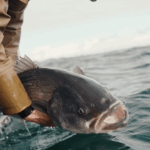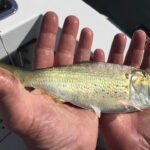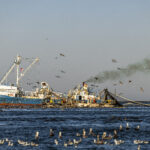
Release Mortality Revisited: New Research from Massachusetts DMF
Feature Photo Credit: Robbie Tartaglia What’s going on? For decades, striped bass management relied on a
By Will Poston, Policy Associate
Two weeks ago, the Mid-Atlantic Fishery Management Council (MAFMC) hosted its June meeting to take final action on two issues of great interest to the recreational community: the Recreational Reform Initiative’s Harvest Control Rule Framework/Addenda (HCR) and a second attempt to rebuild Atlantic mackerel. Below, we’ll break down what decisions were made, describe how they may impact recreational folks, and lay out some of the key uncertainties that remain.
A New Rebuilding Plan—and Recreational Limits—for Atlantic Mackerel
Let’s start with the Atlantic mackerel rebuilding plan, which is a vital issue to many, but its complexity pales in comparison to the thicket that is the HCR.
According to the most recent stock assessment, Atlantic mackerel are overfished (at about a quarter of the target level), and overfishing has been occurring for the past 30 years. While that finding may not square with big mackerel numbers that a lot of folks north of Cape Cod are seeing, it’s not inconsistent with high localized abundance in the western Gulf of Maine even as the stock as a whole is doing poorly. A rebuilding plan to recover the species was approved and implemented in 2019, but the most recent stock assessment in 2021 found that rebuilding was not going to succeed due to persistent poor recruitment (spawning success). As a result, the MAFMC initiated the process to implement a second rebuilding plan for the species. ASGA became involved in this discussion because Atlantic mackerel are both a key forage fish for marine ecosystems and an important bait source for striped bass and bluefin tuna anglers in the Northeast.
Our position, which both recognized the need for the recreational sector to assume some of the burden in rebuilding the stock but also acknowledged the importance of recreational mackerel retention, is summarized in our comment letter to the MAFMC—we’re grateful to the Rhode Island Saltwater Anglers Association for joining us on the letter.
Without getting into the weeds of alternatives on the table, at the meeting the MAFMC voted to approve our preferred rebuilding option: Rebuilding Plan Alternative 4, which implements a constant fishing mortality rate and has a 61% of rebuilding the stock by 2032. In addition, the MAFMC voted to implement a 20-fish per person recreational possession limit for 2023—in other words, if there are, say, four people on a vessel, a maximum of 80 mackerel can be in the livewell and/or the cooler. This was similar to our preferred alternative of 15 fish (the more liberal of the two options initially put forward). Our hope is that this measure won’t too severely negatively impact guides and anglers while also helping to put the stock on an upward trajectory. As additional stock information and rebuilding updates become available, these approaches may change.
Approval of a Harvest Control Rule Approach
Now—deep breath—let’s walk through the Harvest Control Rule (HCR). You may remember our blog last August, which largely conveyed our concerns around both the substance (could the HCR enable overfishing?) and the process (its speed, the lack of scientific review, the degree of complexity in the information presented to the public, etc.) behind this effort. While some of these concerns have been at least partially addressed, there remain some key unknowns as to how exactly the HCR will work in practice—and how some of its elements will comply with the requirements of federal law—even as managers charge ahead to implement it. In addition to our explanation below, we recently recorded a podcast with MAFMC member Dr. Michelle Duval to discuss the HCR and its implications: Listen here.
The details of the HCR are excruciatingly complex. To cut it down to its simplest terms, the HCR is a joint effort between the MAFMC and Atlantic States Marine Fisheries Commission (ASMFC) that would consider factors other than just fishery performance (how many fish we caught versus how many fish we were allowed to sustainably catch) for developing recreational measures for black sea bass, summer flounder, scup, and bluefish (once bluefish are rebuilt). This has all come about because the process for setting recreational measures in recent years has been, to say the least, tumultuous.
Just take last year’s process as an example: black sea bass and scup stocks are both at around double their biomass targets, but management called for substantial reductions because the recreational sector has consistently and considerably exceeded its recreational harvest limit (RHL). On the other hand, summer flounder are not nearly as abundant—as evidenced by both the most recent stock assessment and observations by folks on the water—yet the current management process allowed for a substantial liberalization due to harvest underages. Ultimately, the MAFMC and ASMFC approved recreational reductions for black sea bass and scup and a liberalization for summer flounder—exactly the opposite of what many thought should have happened.
While we have been skeptical of what the HCR could mean for the long-term sustainable management of these fisheries throughout its two years of development, we understand the frustration anglers are feeling and appreciate the pickle managers are in. Staff at the MAFMC and ASMFC certainly deserve recognition for their extensive efforts to develop these alternatives.
With all of this in mind, the MAFMC and ASMFC Policy Board scheduled a meeting for June 7th to take final action on one of the four proposed HCR alternatives.
The leadup to the June meeting was not without its fireworks and curveballs as a series of letters and reports made this complex issue even more confusing and uncertain. Council staff and the Scientific and Statistical Committee both highlighted their strong concerns with the HCR approaches under consideration and opposed selecting any of the four approaches at the meeting. NOAA Fisheries’ Greater Atlantic Regional Fisheries Office (GARFO), meanwhile, penned a response rejecting both of those bodies’ conclusions and pressuring final action on something other than status quo.
Needless to say, many of us following the HCR discussion were expecting a hectic meeting. Staff spent the bulk of the meeting’s scheduled three hours in presentation mode explaining the HCR approaches and other options, which again underscores how complex and confusing this document was. Nevertheless, in the end managers did indeed take final action on all of the decision items—and with very little opposition.
Here is what was approved:
Makes perfect sense…right?! If not, you’re not alone—many stakeholders and managers who are steeped in fisheries management procedures and the technicalities struggled (and are struggling) to fully wrap their heads around the document and the final approved motions. And while what’s done is done, we can’t help but think that the HCR should have never been an Addenda/Framework—it should have been a full Amendment that allowed robust opportunity for public input at several stages. Unfortunately, however that ship has long sailed.
Where Do We Go from Here?
So, what does this mean for future management? Well, bluefish, which are in the midst of a rebuilding plan, are shielded from this new management approach until they’re declared rebuilt. By most accounts, summer flounder are not in great condition—below-average recruitment has been an issue since 2011 and biomass is 14 percent below the target. So, there’s a hope that the approved Percent Change Approach could benefit stocks below biomass targets by being even more precautious than the traditional strategy would have called for, because it would add new management directives for different biomass levels—more conservative management when biomass is lower, and vise versa.
But for black sea bass and scup, which are again doing very well, the implications of this approach are more uncertain, both legally and in regard to long-term sustainable management. After all, despite black sea bass being at high biomass levels, the recreational sector has consistently harvested more fish than we were allotted (although, it’s worth noting, up to now this does not seem to have harmed the stock). However, this presents challenges for both preventing overfishing and maintaining equity among participants in the fishery (e.g., commercial and recreational). If the recreational sector is permitted to exceed its science-driven catch limits and also contributes towards overfishing, that’s a pretty serious issue that will only fuel further sector-sector disputes and jeopardize future stock health.
As said before, it’s a tough spot to be in. There are a lot of black sea bass in the water right now, yet anglers then see their bag, size, and season limits restricted. It’s an apparent disconnect that plagues managers, because they do not want lose the faith and engagement of the angling public. But they also are required to manage fisheries according to the best available science and to adhere to the Magnuson-Stevens Act, a law at the core of sustainable fisheries management here in the U.S.
In the short-term, the approved motion might be okay. Will it be a silver bullet to the issues within recreational fisheries—lack of real-time, precise data or real ability to control outcomes? No, it won’t, but it will serve as a placeholder until some other interesting management approaches are further developed and the two recreational fleet models are finalized. Also, staff are expected to begin developing some of the other components of the broader Recreational Reform Initiative, which we’ll be tracking and keeping everyone up-to-date on. But for next year’s recreational measures, well we will have to wait for final catch accounting estimates later this August and further into the fall.

Feature Photo Credit: Robbie Tartaglia What’s going on? For decades, striped bass management relied on a

Recent developments in the 2025 Atlantic Menhaden Stock Assessment Update, released by the Atlantic States

What’s going on? The “most important fish in the sea” just exposed one of the

Mario CampoFisheries Ecologist, Southeastern Louisiana UniversityScience and Policy Associate, American Saltwater Guides Association This discussion
We rely on our members and donations to keep fighting for a sustainable tomorrow in marine conservation.
GIVE THE GIFT OF FISHERIES CONSERVATION THIS HOLIDAY SEASON. SHOP ASGA GOODS THAT FUND FISHERIES RESEARCH & ADVOCACY CAMPAIGNS
JOIN ASGA IN CALLING FOR CRITICAL MANAGEMENT ACTION AFTER YEARS OF SPAWN FAILURES & POOR MANAGEMENT.
By using this website, you agree to our use of cookies. We use cookies to provide you with a great experience and to help our website run effectively. To learn more, please review our privacy policy.
One Response
Does anyone bother to address the real issue. Commercial draggers! They are non stop working the south shore of Rhode Island. I watched them throw half dead stripers back in the water about 8 feet from my boat as they set their net for the 50th time that day. The rest of the smaller fish were either dead or got the hook and were flung over. Until that type of fishing is stopped once and for all the rest of these efforts are simply bs.